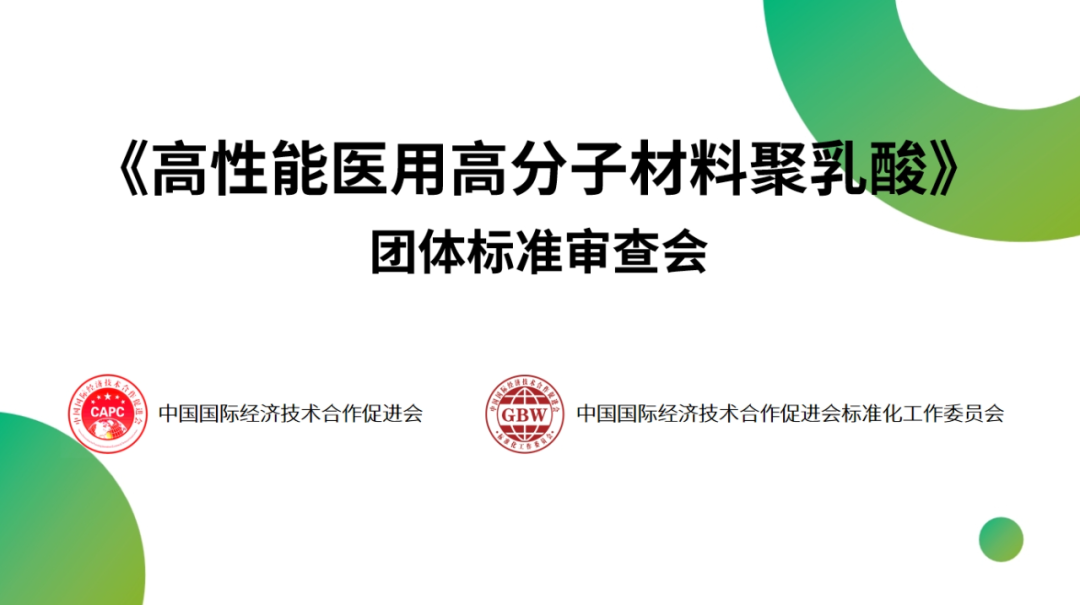As a high-performance biomedical polymer material, polylactic acid (PLA) has extensive applications and plays an important role in the medical field. With its excellent biocompatibility, biodegradability, and processability, PLA has become the ideal material for various medical applications, sparking a green revolution in the healthcare industry.
Recently, the group standard review meeting for “High-Performance Biomedical Polymer Material Polylactic Acid” was successfully held, jointly organized by the Standardization Working Committee of the China International Economic and Technical Cooperation Promotion Association (hereafter referred to as “CIEC Standardization Committee”) and the Tongbiao Zhongyan Standardization Technical Research Institute.

The meeting was chaired by Wang Xia, the head of the CIEC Standardization Committee, with the attendance of Chen Meng, Deputy Leader of the Standard Drafting Group and Deputy Director of the Standard Department, and Wang Xiaoshu, from the Standard Department. Representatives from Shenzhen eSUNMED Biotechnology Co., Ltd., Chengdu Dikon Pharmaceuticals Co., Ltd., the Ningbo Institute of Materials Technology and Engineering, Chinese Academy of Sciences, the Changchun Institute of Applied Chemistry, Chinese Academy of Sciences, Zhejiang Shengji Materials Technology Co., Ltd. (a subsidiary of East China Pharmaceutical Group), Changchun Shengboma Biomaterials Co., Ltd., Narui Bio-pharmaceutical Technology (Chongqing) Co., Ltd., and Tongbiao Zhongyan Standardization Technical Research Institute, along with relevant industry experts, attended the review meeting.
At the meeting, Wang Xia introduced the development and work content of the CIEC Standardization Committee since its establishment. Wang Xiaoshu provided a detailed report to the expert panel and participating organizations on the background, formulation process, principles, framework, and key technical contents of the “High-Performance Biomedical Polymer Material Polylactic Acid” group standard. Discussions were focused on the environmental, energy, and safety advantages of PLA materials in medical applications.
During the standard discussion session, industry experts and representatives of participating organizations conducted a chapter-by-chapter review of the group standard, including its scope, normative references, terms and definitions, requirements, testing methods, and inspection rules. There was unanimous agreement that the standard was based on existing industry-related technical indicators and requirements, and adhered to the principles of comprehensiveness and systematization. It optimizes the production process of PLA materials and regulates their degradation rate and mechanical performance to further enhance their biocompatibility and application performance. The expert panel stated that PLA, often referred to as the “king of degradable materials,” produces non-toxic and harmless degradation products, and possesses unparalleled environmental protection features. Furthermore, enhancing the production and research of PLA materials will break the existing limitations of medical materials’ application frameworks and clinical usage, significantly improving and upgrading the current medical environment in China.
At the end of the meeting, Deputy Director Chen Meng summarized the discussions. She emphasized that in order to further enhance the performance of PLA and ensure its safety and reliability in the medical field, it is particularly important to establish corresponding standards. The formulation of this standard aims to regulate the synthesis and modification processes of PLA, improve its mechanical, thermal, and degradation properties, and enable it to better adapt to various application environments. This will promote the development and innovation of related industries and have a profound impact on the sustainable development of the biomedical field.
Given the basic requirements of China’s overall plan for modernizing the healthcare system and the sustainable development strategy, the application of PLA in the medical field will continue to expand. This will not only help improve the quality and efficiency of medical services but also reduce the environmental pollution caused by medical waste, meeting the medical industry’s demand for high-quality, multifunctional, and environmentally friendly products.


